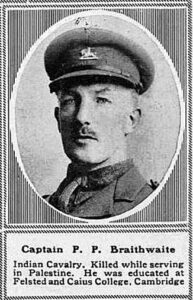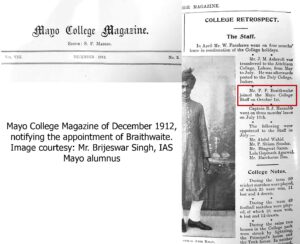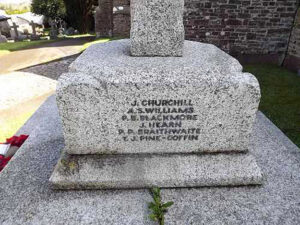C.K. Ramachandran writes about an unlikely friendship forged in early-twentieth-century, between Gopalan Nair, a scholar from Malabar, and Philip Braithwaite, an English school inspector.
C K Ramachandran
Pandit P. Gopalan Nair is a household name today, as the scholar who introduced Srimad Bhagavatham to Malayalee Hindu households. Apart from the eight-volume Bhagavatham, he had annotated and translated several holy books of Hinduism like the Ramayana, Brahmasutra and Bhagavad Geetha.
Gopalan Nair was born into a family of very limited means in Kollengode, Palakkad district, Kerala. His father, a Brahmin priest of a few temples, could hardly support his family. The elder son of the couple had an intellectual disability and died at the age of fifteen. Naturally, the couple was worried about the younger son, Gopalan and did not send him to school till he was eight years of age. He was then sent to the ezhuthupally where he learnt the basics of Sanskrit language and literature.
He spent four years at the ezhuthupally when it was taken over by an English school, and Gopalan Nair became a student of the second standard in the English school. As he was the senior-most student in the school, his teacher used to assign him to teach the lower classes.
But misfortune followed him there as well. He had to terminate his English education in the third standard, as his widowed mother could not afford to send him to school. He had just about started to grasp the English language which fascinated him no end.
Gopalan Nair went back to his Sanskrit studies for the next two years under a local Sanskrit scholar. However, the financial position of his household had become so precarious that he had to look out for a job. Thus, at the age of 16, he joined the timber depot of his uncle in Vallangi as an accountant.
The next year, in 1885, his uncle passed away and he was saddled with the responsibility of managing the timber depot on his own. Soon he had to give up the enterprise and return to Kollengode where he was offered a teacher’s job. After undergoing teacher’s training, he became the Sanskrit and Malayalam Pandit at the High School run by the Kollengode Raja, Sri Vasudeva Raja.
The Young Inspector of Schools

Philip Pipon Braithwaite was a young Inspector of School covering the area of Malabar and Mangalore, headquartered in Cannanore. He had come to India with outstanding credentials. He graduated in History from Caius College, Cambridge where he was known as a keen debater, a great footballer and a champion boxer. In 1905, he was appointed the Vice Principal of the prestigious Teachers College, Saidapet, Chennai. This College, established in 1856 is today known for its illustrious alumni, including two former Presidents of India, Dr Sarvepalli Radhakrishnan and R Venkataraman, as well as Anantasayanam Ayyangar, the First Deputy Speaker and later the second Speaker of Lok Sabha.
After spending a year and a half at the Saidapet College, Braithwaite was promoted to Inspector of Schools in Malabar. During this posting, he had to visit the entire Malabar province, including the Canara districts, to inspect the English schools.
As soon as he had decided to serve in South India, Braithwaite had joined the Southern Provinces Mounted Rifles, a volunteer force formed in 1904. It had a blue uniform with white facings and the insignia was a strung bungle with the initials SPMR.
Malayalam Tutor
Braithwaite made friends among the teaching and management staff with ease. One such friend was Vasudeva Raja, the owner and manager of Kollengode Raja’s High School. Braithwaite asked the Raja, during one of his visits to Kollengode, to look for a teacher to coach him in Malayalam, as he was required to pass a departmental test in the language of the region. Raja had no hesitation in recommending Pandit Gopalan Nair who was teaching Malayalam and Sanskrit in his school.
Thus began an unlikely friendship between the saintly Pandit and the dashing Cambridge don who was half his age, but was his supervising officer. Nair left his job in 1910 and proceeded to Kannur where he stayed for the next 19 months as the resident tutor of young Braithwaite. The Malayalam test for which Braithwaite had engaged Nair was over in 10 months. Expectedly, Braithwaite did splendidly in the test. But, by then, his interest had shifted to learning Sanskrit and Vedanta. For the next 9 months, Nair taught him Sanskrit and Bhagavad Gita which he found fascinating.
Pandit Gopalan Nair had started his Bhagavatham annotation in 1909. It was his good fortune that Braithwaite’s offer came in 1910. For the next two years, he could continue the work of translating the massive work of 18,000 verses. Braithwaite engaged him only for one hour in the morning and another hour in the evening. Pandit was free to pursue his passion for the rest of the day unhindered by the boring routine of classroom teaching and disciplining students. 
Another advantage during this period was that his pupil took him along wherever he toured on duty. This took him to many places in Kerala and Coorg. It was on one such trip to the Nilgiris – where Braithwaite was vacationing during his summer holidays – that Gopalan Nair learnt that he had become a father. All he could do was write to his wife assuring her that he would make it for the boy’s choroon (ceremonial rice giving) to be held in Guruvayur temple in 6-months. So engrossed was he in the Bhagavatham translation that he could only fulfil this promise after four years.
Meanwhile, a spectacular Delhi Durbar was being planned for 1911. The Durbar, pageantry of pomp and splendour, was significant on two counts: unlike in the previous Durbars of 1877 and 1903, the Emperor, King George V, himself would be attending in 1911. Secondly, the shifting of the Imperial Capital from Calcutta to Delhi would be announced in this Durbar. The ceremonial procession included forces from all over the country including British and native forces. Braithwaite was selected to represent the Southern Provinces Mounted Rifles. The roll of honour of the Delhi Durbar lists the name of 2nd Lieutenant Braithwaite PP, Southern Provinces Mounted Rifles, of the Education Department, Cannanore, as a recipient of the 1911 Delhi Durbar Medal.
Mayo College, Ajmer
Soon after, Braithwaite got posted as a member of the faculty of the prestigious Mayo College, which was founded in Ajmer, Rajasthan by the Viceroy to provide modern education exclusively to the sons of maharajas. The Viceroy had described it as the Eton of the East. Braithwaite was delighted to go there, as it was a rare honour and a welcome change from inspecting native schools. But, he was reluctant to let go of his teacher, Gopalan Nair, and offered to take him to Ajmer as a language teacher. But Gopalan Nair had to decline the offer as his family circumstances did not permit him to leave Kollengode for long periods. He bid farewell to his favourite student and returned to Kollengode.

The World War and the Battle of Palestine
Braithwaite had only been working at Ajmer for a couple of years when the World War broke out in 1914. He immediately applied for a commission in the Indian Army Reserve of Officers, and following a year-long training at Meerut as a Second Lieutenant with the 21st Cavalry, was sent to join the 36th Cavalry (Jacob’s Horse) which was deployed in France. Until he left the shores of India, he used to send regular letters to Gopalan Nair about his welfare. He got promoted to Lieutenant and saw action in various battles in France.
He was promoted to Captain in 1917 when his regiment moved to Palestine. The 11th Cavalry Brigade to which the 36th (Jacob’s) Horse was attached, was pursuing the Turks who were attempting to escape across River Jordan. The troops under Captain Braithwaite had gone too far in pursuit of the enemy and were almost surrounded by Germans. Only four or five of his men made it back that afternoon. The Captain was among those killed on 28th September 1918, a few weeks before the Germans signed the armistice agreement on 11th November 1918.

Braithwaite’s father, Canon Philip Braithwaite wrote: ‘It is a great comfort to feel that all who knew him admired his noble character. He crowned as it were his beautiful life by dying in a holy cause in the Holy Land’.
It was his sister who broke the news to Gopalan Nair in a letter. According to the biography of Pandit Gopalan Nair written by Sri P Rajagopalan, Gopalan Nair used to describe Braithwaite as ‘a perfect friend, model disciple and the embodiment of gratitude’. Gopalan Nair had invited his distinguished pupil to preside over the annual day function of his school. In his speech in Malayalam, Braithwaite described himself thus: ‘While I am second to none in my respect towards my guru, I have been a worthless disciple’.
The guru, in his turn, would reminisce about the warmth of his disciple’s friendship for the rest of his long life.
References
- Rajagopalan, P.1990. Pandit P Gopalan Nair. Thiruvananthapuram: Department of Cultural Publications, Government of Kerala.
- Paul’s Medals and Documents Collection, Facebook page.
Editors’ Note: This is a slightly modified version of the article originally published on the Calicut Heritage blog. The author has also contributed a short biography of Captain Braithwaite to the Surrey Heritage site.
About the Author: C. K. Ramachandran is a former civil servant and the founder-convenor of Calicut Heritage Forum. He blogs at calicutheritage.blogspot.com.

Very nice article CK, Gopalan Nair was a family friend and well know to our previous generations !
Sir I want to visit the birth place of pandit ji,…kollangode any memorial available here